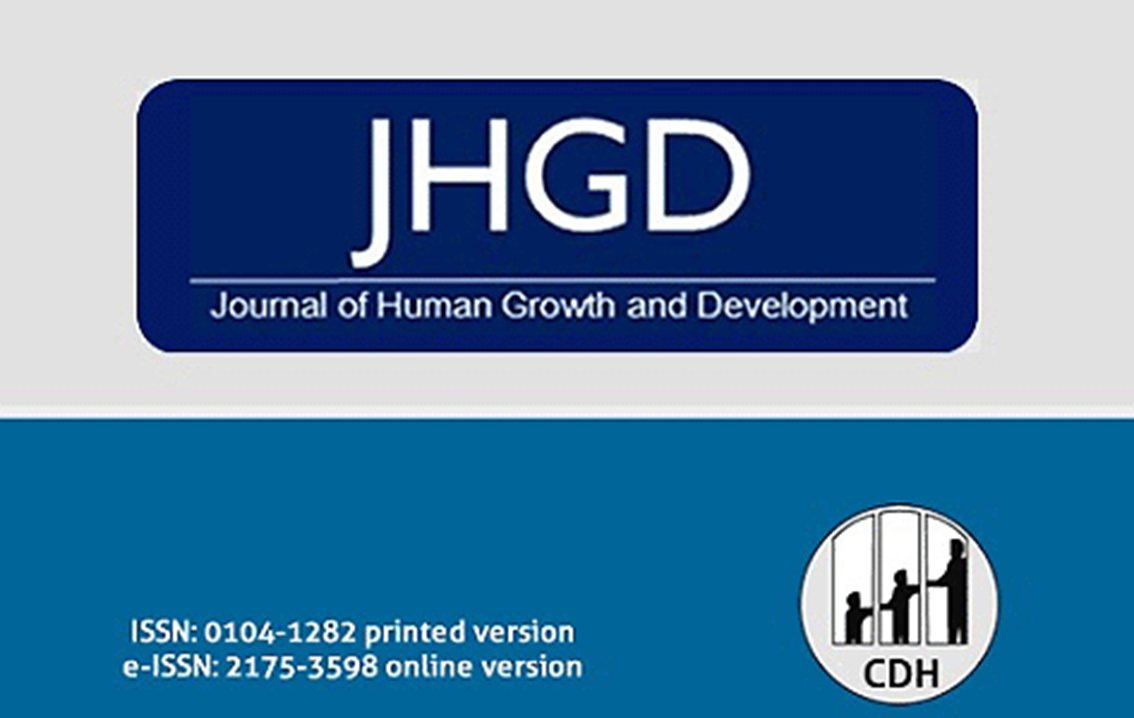Narrativa escrita de escolares com e sem dificuldade de consciência sintática
DOI:
https://doi.org/10.7322/jhgd.v30.11082Palavras-chave:
linguagem infantil, Transtornos do desenvolvimento da linguagem, narrativa, escrita manual, transtornos de aprendizagem, consciência sintáticaResumo
Introdução: A consciência sintática é uma habilidade metalinguística e é definida como a capacidade da criança em refletir sobre os processos formais relativos à organização
das palavras em frases e manipulá-los. Esta é uma habilidade ainda pouco explorada no contexto de aprendizagem escolar, sendo pouco descrito a sua importância no processo de aprendizagem escolar de crianças falantes do português.
Objetivo: Comparar a narrativa escrita entre crianças com e sem dificuldade em consciência sintática.
Método: Participaram 60 crianças (idade média 9,4 anos; DP: 0,9) matriculadas no 4º e 5º ano do ensino fundamental de uma escola municipal, divididas em dois grupos, de acordo com seu o desempenho na tarefa de consciência sintática – G1 (crianças com desempenho médio/elevado em consciência
sintática) e G2 (desempenho rebaixado). Após a avaliação da habilidade de consciência sintática, cada criança elaborou um texto narrativo escrito baseado em uma figura estímulo que foi analisado nos aspectos grafia, erros ortográficos, uso das
classes gramaticais e o conteúdo. Para comparação entre os grupos usou-se o teste T – student (α = 0,05).
Resultados: As crianças do G2 apresentaram grafia
alterada; maior ocorrência de erros ortográficos, sendo estes principalmente do tipo relação fonografêmica irregular; apoio na oralidade e dificuldade com marcadores de nasalização;
textos curtos com preferência do uso de substantivos e verbos, além de dificuldades com a estruturação do texto, uso de pontuação e vocabulário, enquanto que o G1 utilizou mais
verbos e pronomes no lugar dos substantivos.
Conclusão: Crianças que apresentam adequada habilidade de consciência sintática conseguiram elaborar narrativas escritas com maior competência, demonstrando aquisição de aspectos ortográficos e desenvolvimento da coerência textual.
Referências
Spinillo AG, Simões PO. Desenvolvimento da consciência metatextual em crianças: questões conceituais, metodológicas e resultados de pesquisas. Psicol Refl Crít. 2003;16(3):537-46. DOI: http://dx.doi.org/10.1590/S0102-79722003000300012
Correa J. A avaliação da consciência morfossintática na criança. Psicol Refl Crít. 2005;18(1):91-7. DOI: http://dx.doi.org/10.1590/S0102-79722005000100012
Cain K. Syntactic awareness and reading ability: is there any evidence for a special relationship? Appl. Psycholinguist. 2007;28(4):679-94. DOI: https://doi.org/10.1017/S0142716407070361
Capovilla AGS, Capovilla FC, Soares JVT. Consciência sintática no ensino fundamental: correlações com consciência fonológica, vocabulário, leitura e escrita. Rev Psico-USF. 2004;9(1):39-47.
Guimarães SRK, Paula FV. O papel da consciência morfossintática na aquisição e no aperfeiçoamento da leitura e da escrita. Educ Rev. 2010;(38):92-111. DOI: http://dx.doi.org/10.1590/S0104-40602010000300007
Guimaraes SRK. The role of morphosyntactic awareness in conventional lexical segmentation. Paidéia. 2013;23(55):225-33. DOI: http://dx.doi.org/10.1590/1982-43272355201310
Hage SV, Azevedo NC, Nicolielo-Carrilho AP, Tabaquim MMDL. Syntactic awareness and text production in brazilian portuguese students with learning disabilities. Folia Phoniatr Logop. 2015;67:315-20. DOI: https://doi.org/10.1159/000444919
Tong X, Deacon SH, Cain K. Morphological and syntactic awareness in poor comprehenders: another piece of the puzzle. J Learn Disabil. 2013;47(1):22-33. DOI: http://dx.doi.org/10.1177/0022219413509971
Chung KK, Ho CS, Chan DW, Tsang SM, Lee SH. Contributions of syntactic awareness to reading in Chinese-speaking adolescent readers with and without dyslexia. Dyslexia. 2013;19(1):11-36. DOI: http://dx.doi.org/10.1002/dys.1448
Guan CQ, Ye F, Wagner RK, Meng W, Leong CK. Text comprehension mediates morphological awareness, syntactic processing, and working memory in predicting chinese written composition performance. J Educ Psychol. 2014;106(3):779-98. DOI: http://dx.doi.org/10.1037/a0035984
Tong X, Tong x, Shu H, Chan S, McBride-Chang C. Discourse-level reading comprehension in chinese children: what is the role of syntactic awareness? J Res Reading. 2014;37(1):S48-70. DOI: http://doi.org/10.1111/1467-9817.12016
Brimo D, Apel K, Fountain T. Examining the contributions of syntactic awareness and syntactic knowledge to reading comprehension. J Res Reading. 2017;40(1):57-74. DOI: http://doi.org/10.1111/1467-9817.12050
Deacon SH, Kieffer M. Understanding how syntactic awareness contributes to reading comprehension: evidence from mediation and longitudinal models. J Educ Psychol. 2017;110(1):72-86-15. DOI: http://doi.org/10.1037/edu0000198
Bizama M, Arancibia B, Sáez, K, Loubiès L. Conciencia sintáctica y comprensión de lectura en niñez vulnerable. Rev. Latinoam Cienc Soc. Niñez Juv. 2017;15(1):219-32. DOI: http://doi.org/10.11600/1692715x.1511323012015
Capovilla FC, Capovilla AGS. Prova de Consciência Sintática (PCS): normatizada e validade para avaliar a habilidade metassintática de escolares de 1ª a 4ª séries do ensino fundamental. São Paulo: Memnom, 2006.
Rego LL, Buarque LL. Consciência sintática, consciência fonológica e aquisição de regras ortográficas. Psicol Refl Crít. 1997;10(2):199-217. DOI: http://dx.doi.org/10.1590/S0102-79721997000200003
Guimarães SRK. Influência da variação linguística e da consciência morfossintática no desempenho em leitura e escrita. Inter Psicol. 2005;9(2):261-71. DOI: http://dx.doi.org/10.5380/psi.v9i2.4795
Belinchón M, Igoa JM, Rivière A. Psicología del lenguaje. Investigación y teoría. Madrid: Trotta; 2000.
Costa ER, Boruchovitchb. As Estratégias de Aprendizagem e a Produção de Textos Narrativos. Psicol. Refl. Crít. 2009;22(2):173-80. DOI: http://doi.org/10.1590/S0102-79722009000200002
Zuanetti PA, Novaes CB, Silva K, Mishima-Nascimento F, Fukuda MTH. Main changes found in written narratives productions of children with reading/writing difficulties. Rev CEFAC. 2016;18(4):843-53. DOI: http://doi.org/10.1590/1982-021620161843116
Silva MEL, Spinillo AG. Uma análise comparativa da escrita de histórias pelos alunos de escolas públicas e particulares. Rev Bras Est Pedag. 1998;73(193):5-16.
Nobre FSS, Bandeira PFR, Valentini NC. Academic achievement associated with motor performance and sex in diifferents subcultures. J Hum Growth Dev. 2017; 27(2):213-18. DOI: http://doi.org/10.7322/jhgd.115027
Okuda PMM, Lourencetti MD, Santos LCA, Padula NAMR, Capellini SA. Coordenação motora fina de escolares com dislexia e transtorno do déficit de atenção e hiperatividade. Rev CEFAC. 2011;13(5):876-85. DOI: http://doi.org/10.1590/S1516-18462011005000048
Miilher LP, Ávila CR. Variáveis linguísticas e de narrativas no distúrbio de linguagem oral e escrita. Pró-Fono. 2006;18(2):177-88. DOI: http://doi.org/10.1590/S0104-56872006000200007
Bigarelli JFP, Avila CRB. Habilidades ortográficas e de narrativa escrita no ensino fundamental: características e correlações. J Soc Bras Fonoaudiol. 2011;23(3):237-47. DOI: http://doi.org/10.1590/S2179-64912011000300009
Downloads
Publicado
Edição
Seção
Licença
Copyright (c) 2020 Ana Claudia Constant Soares, Patrícia Aparecida Zuanetti, Kelly da Silva

Este trabalho está licenciado sob uma licença Creative Commons Attribution 4.0 International License.







